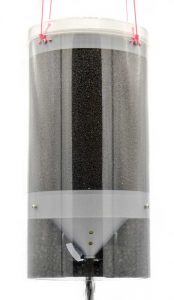What is a Balloon Ballaster?
A balloon ballaster is a device to drop metered amounts of ballast to control flight altitudes.
The HAB Ballaster is a device that can release measured amounts of ballast on command. It is a stand-alone module that is light enough to be used on latex weather balloons, while having a ballast capacity large enough to be used on plastic balloons.
Why use the Balloon Ballaster?

To control the balloon’s altitude or ascent rate.
Releasing ballast reduces the mass that the balloon is lifting, increasing the overall buoyancy of the balloon/payload system. Releasing ballast causes an already ascending balloon to ascend faster, or it can slow or stop a descending balloon.
On zero-pressure balloons, releasing ballast will cause the balloon to float at a higher altitude. It is also needed to offset night-time lift-gas cooling to stay afloat when the sun is no longer warming the balloon—diurnal ballast, usually requires releasing 6-8 % of the total system mass per night.
How do you use the HAB Ballaster?
Send it a real-time command.
This Balloon Ballaster can be controlled either via a Bluetooth Low-Energy (BLE v4 or v5) radio link, or via a wired UART interface. It uses simple ASCII commands to drop measured amounts of ballast and provide system status. It can be tested on the ground using a smart-phone app.
Two cold-protected batteries on the Balloon Ballaster provide the necessary power for flights up to two days. For longer-duration flights, additional batteries or solar panels can be incorporated.
What is the ballast media for the HAB Ballaster?
Sand, a granular material composed of finely divided rock and mineral particles. (Wikipedia)
The HAB Ballaster is designed to use sand. Sand ballast is an easily source-able material worldwide, is environmentally benign, and does not present a falling hazard. Other materials such as steel shot are possible, but these types of ballast may interfere with onboard radio transmissions.

Thanks for sharing!